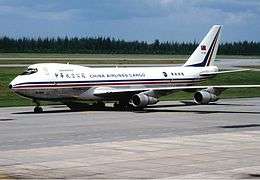China Airlines Flight 334
China Airlines Flight 334 was a Boeing 747-200F freighter aircraft that was hijacked by pilot Wang Xijue (Chinese: 王錫爵) on May 3, 1986 while en route to Don Mueang, Thailand. Wang managed to subdue the two other crew members and changed course to land the 747 in Guangzhou, where he defected to the People's Republic of China. The incident forced the Chiang Ching-kuo government in Taiwan to reverse its Three Noes policy in regard to contacting the communist government in mainland China, and Chiang dispatched several delegates to Hong Kong to negotiate with mainland officials for the return of the aircraft and crew. The incident was credited as a catalyst in renewing cross-strait relations between mainland China and Taiwan.[1][2]
 B-198, the aircraft involved, at Changi Airport a year before the incident. | |
| Hijacking | |
|---|---|
| Date | May 3, 1986 |
| Summary | Hijacking |
| Site | Guangzhou Baiyun Airport, Guangdong, China |
| Aircraft | |
| Aircraft type | Boeing 747-200F |
| Operator | China Airlines |
| Registration | B-198 |
| Flight origin | Changi Airport, Singapore |
| 1st stopover | Don Mueang Airport, Bangkok, Thailand |
| 2nd stopover | Kai Tak Airport, Hong Kong |
| Destination | Chiang Kai-shek Airport, Taoyuan, Taiwan |
| Passengers | 0 |
| Crew | 3 |
| Fatalities | 0 |
| Survivors | 3 |
Aircraft
The aircraft was a Boeing 747-2R7F/SCD freighter,[note 1] registration B-198, built in September 1980 originally for Cargolux (as LX-ECV). The ROC Ministry of Transportation Civil Aviation Authority acquired the aircraft in June 1985 and then leased it to China Airlines. On 29 December 1991, this aircraft, later operating as China Airlines Flight 358, hit a hillside near Wanli, Taiwan after the separation of its number three and four engines, killing all five crew on board.
Incident
The following times are all in the Beijing/Taipei/Hong Kong time zone (UTC+8).
May 3
- 5:50 AM: China Airlines freighter aircraft took off from Singapore, headed for Bangkok.
- 2:40 PM: China Airlines freighter aircraft flew pass the IDOSI reporting point, about 120 nautical miles to the southeast of Hong Kong. It followed orders from Hong Kong Air Traffic Control and descended from 33,000 feet.
- 2:45 PM: Wang Xijue (王錫爵) attacked Dong Guangxing (董光興) with an emergency axe, and also subdued and handcuffed him.
- 2:50 PM: Chiu Mingzhi (邱明志; Qiū Míngzhì), who came back from the restroom, started to fight with Wang Xijue.
- 2:50 PM: Hong Kong ATC, upon discovering that China Airlines 334 has not descended to the appropriate height, ordered it to descend.
- 3:00 PM: About 50 nm from Hong Kong FLIR, Wang Xijue began calling Guangzhou Baiyun airport control tower, to the surprise of Hong Kong ATC. The ATC staff requested the final landing destination. At this point the aircraft was at about 15000 feet.
- 3:07 PM: Scheduled arrival time at Hong Kong Kai Tak; HK ATC observes the plane continued to fly north.
- 3:08 PM: Another crew member threatened to cause a dangerous situation on the plane. A stall warning was issued at altitude 4500 feet AMSL. Qiu Ming raised the flaps, risking crashing into the sea.
- 3:13 PM: Wang Xijue received flight assistance through official Chinese civil aviation, who called Guangzhou Baiyun International Airport.
- 3:45–3:50 PM: Plane landed and pilots were apprehended, giving conflicting stories.
Aftermath
By forcing the ROC (Taiwan) to communicate with PRC (China), Flight 334 was the first step in the thawing of relations. It effectively ended the Three Noes policy and ultimately led to the reunification of families across the straits a year later and has led to officially establishing the Three Links that were originally outlined in a 1979 PRC proposal by 2008. In 1987 the ROC officially ended martial law due to thawing relations and other global realities, like the declining influence of communist aligned parties like the Soviet Union.
See also
- Ethiopian Airlines Flight 702
- Germanwings Flight 9525
- JetBlue Flight 191
- FedEx Flight 705
Notes
- The aircraft was a Boeing 747-200 model; Boeing assigns a unique code for each company that buys one of its aircraft, which was applied as a suffix to the model number at the time the aircraft was built, hence "747-2R7". This aircraft was a freighter with a large door in its side for loading cargo, hence "747-2R7F/SCD" for Freighter/Side Cargo Door.
References
- "Pilot lands in China, asks to defect" Chicago Tribune. May 4, 1986.
- 21年前劫机留谜团 王锡爵北京度晚年. Lianhe Zaobao (in Chinese). 2007-11-04.